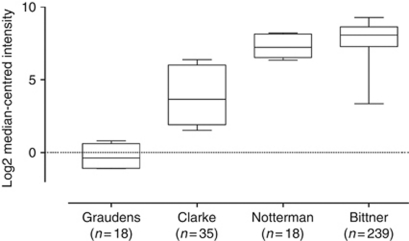Sir,
We have read with great interest the study by Kontos et al (2010) in British Journal of Cancer about the use of L-DOPA decarboxylase as a prognostic marker for colorectal adenocarcinoma.
To assess the expression level of L-DOPA decarboxylase transcripts, the authors have performed qRT-PCR using GAPDH as the dedicated housekeeping gene (HKG) to normalise their results. However, no results concerning the stability of GAPDH that has lead to its use as the best housekeeper in their model system were available.
We have recently shown on human cell lines that choosing an unstable internal control gene could generate dramatic misinterpretations (Caradec et al, 2010a). In our study, and in our conditions, GAPDH was one of the most variable HKG so far impairing its use as a relevant normaliser. As this gene is likely to be emblematical to normalise gene expression results, we have developed a specific qRT-PCR with calibration curve to specifically study GAPDH expression in different cell lines grown with various hypoxic conditions. Our results unambiguously showed that GAPDH expression varies according to oxygen tension. We have also analysed GAPDH variability comparing meta-analysis data from microarray experiments on human samples available online (https://www.oncomine.com/resource/login.html). Using Oncomine 4.3, a powerful tool allowing rapid gene expression comparison between healthy and/or tumour human samples, we report here that GAPDH variability differs largely from one study to another and more importantly may largely vary between patients in a given study (Figure 1). As, aside still unidentified factors, hypoxia can be considered as a major one to have a critical role in cancer development, especially in colorectal cancer (Baba et al, 2010), we would be interested in learning how Kontos et al have tested HKGs variability in their system and found GAPDH to be the most relevant.
Figure 1.
GAPDH fold change in different colon adenocarcinoma studies (Graudens et al, 2006; Clarke et al, 2003; Notterman et al, 2001 and Bittner, not published (International Genomics Consortium, Expression Project for Oncology - Colon Samples, http://www.ncbi.nlm.nih.gov/geo/query/acc.cgi?acc=GSE2109)). Zero on the bar chart scale represents no change, with each increment on the scale representing a two-fold difference. In Bittner study, it means that the observed 5.922 interval between maximal and minimal values corresponds to a 25.922, i.e., 60 GAPDH fold change.
Another unclear point concerns qRT-PCR Ct intervals between GAPDH and L-DOPA target gene amplification. Indeed, the study results of Kontos et al. showed a ΔCt equal to 13 (Ct (GAPDH) 15, Ct (L-DOPA) 28), signifying that GAPDH transcripts are likely to be expressed 213 (8200) times higher than those encoding L-DOPA. As we stressed this particular point very recently, discussing about the use of r18S as a normaliser (Caradec et al, 2010b), we would be very interested to know Kontos et al. opinion about the accuracy of such disproportion.
Definitely, the choice of a valid HKG set will determine the relevance of the results that will be further interpreted, and so it should be seriously considered.
References
- Baba Y, Nosho K, Shima K, Irahara N, Chan AT, Meyerhardt JA, Chung DC, Giovannucci EL, Fuchs CS, Ogino S (2010) HIF1A overexpression is associated with poor prognosis in a cohort of 731 colorectal cancers. Am J Pathol 176: 2292–2301 [DOI] [PMC free article] [PubMed] [Google Scholar]
- Caradec J, Sirab N, Keumeugni C, Moutereau S, Chimingqi M, Matar C, Revaud D, Bah M, Manivet P, Conti M, Loric S (2010a) ‘Desperate house genes’: the dramatic example of hypoxia. Br J Cancer 102: 1037–1043 [DOI] [PMC free article] [PubMed] [Google Scholar]
- Caradec J, Sirab N, Keumeugni C, Revaud D, Loric S (2010b) Reply: 18S is an appropriate housekeeping gene for in vitro hypoxia experiments. Br J Cancer (this issue) [DOI] [PMC free article] [PubMed]
- Clarke PA, George ML, Easdale S, Cunningham D, Swift RI, Hill ME, Tait DM, Workman P (2003) Molecular pharmacology of cancer therapy in human colorectal cancer by gene expression profiling. Cancer Res 63: 6855–6863 [PubMed] [Google Scholar]
- Graudens E, Boulanger V, Mollard C, Mariage-Samson R, Barlet X, Grémy G, Couillault C, Lajémi M, Piatier-Tonneau D, Zaborski P, Eveno E, Auffray C, Imbeaud S (2006) Deciphering cellular states of innate tumor drug responses. Genome Biol 7: R19. [DOI] [PMC free article] [PubMed] [Google Scholar]
- Kontos CK, Papadopoulos IN, Fragoulis EG, Scorilas A (2010) Quantitative expression analysis and prognostic significance of L-DOPA decarboxylase in colorectal adenocarcinoma. Br J Cancer 102: 1384–1390 [DOI] [PMC free article] [PubMed] [Google Scholar]
- Notterman DA, Alon U, Sierk AJ, Levine AJ (2001) Transcriptional gene expression profiles of colorectal adenoma, adenocarcinoma, and normal tissue examined by oligonucleotide arrays. Cancer Res 61: 3124–3130 [PubMed] [Google Scholar]



